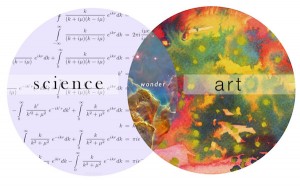The Art of Science and the Science of Art: Editing
Yes, I know it’s been a while since I’ve posted one of these, but I haven’t forgotten about this series! On the topic of art and science, so far I’ve discussed their similarities and differences in reading, writing, and research. Now it’s time to discuss another important part of any type of writing: editing. How do art and science compare when it comes to proofreading your work?
How the Art is like the Science

At the intersection of Art and Science lies Wonder. – The Imaginary Foundation
Editing is an essential part of writing, no less important than the creative part. It’s a practice that every writer must undertake at least at the most basic level. Even if you hand your work off to someone else for proofreading, you still need to be confident in the quality of whatever you’re passing on, and the only one who can make that call is you. Whether you write artistically or scientifically, rewriting is writing, and you can’t expect that writing to go very far unless you give it the care and attention it deserves.
Artists and scientists alike are expected to master the technique of editing. We have to know how to take a step back and review everything we’ve written with a fresh perspective. We must be able to channel our inner writer and our inner critic and learn when to listen to which voice. We have to be able to catch mistakes in a second, third, fourth reading. We need to be able to identify weak points and figure out how to connect all our ideas into one coherent picture. Regardless of our form, style, or content, the ability to edit our own work is indispensable if we wish to be taken seriously in this ever-expanding world of the written word.
At its core, editing is crucial to all forms of writing. The process of editing, however, differs between artistic and scientific writing.
How the Art is unlike the Science
Editing artistic writing is something of a linear process. First, it’s up to the writer to look over their work and make as many changes as they deem appropriate. As the best of us know, this part alone can take weeks, if not months or even years. Once the author is satisfied with their draft, the baton is often passed to an editor, ideally a professional, who provides fresh opinions on how to improve the piece. A back-and-forth between the writer and the editor is encouraged at this stage for the benefit of the work being revised, and some writers choose to include a beta reader or two for additional insight. Novelists who opt for the traditional route also need to wait for their manuscript to be approved by a publishing house, yet another stop on the road to publication. Only when a written work has passed all the checkpoints can it finally reach the public, and while there may be some overlapping along the way, the process as a whole is basically one continuous track.
 Scientific writing, on the other hand, is revised through a sort of “simultaneous editing”. For example, my first experience writing a research paper involved a collaborative effort among me, my professor, and two other authors. One researcher was responsible for most of the writing, then we each had to review the first draft on our own time and send each other our notes so the lead author could incorporate them all into one updated draft for a second round of reviews. This process was repeated several times until we were all satisfied enough with the final draft to submit it for peer review, at which point it was up to another group of researchers to simultaneously read it over and contribute their opinions. Since an academic paper usually takes more than one writer to put together, it’s much more time efficient to have multiple editors review it at the same time throughout the stages from writing to publication, especially in an age when information is emerging faster than we can keep up with it. In short, multiple reviewers plus simultaneous editing equals faster science.
Scientific writing, on the other hand, is revised through a sort of “simultaneous editing”. For example, my first experience writing a research paper involved a collaborative effort among me, my professor, and two other authors. One researcher was responsible for most of the writing, then we each had to review the first draft on our own time and send each other our notes so the lead author could incorporate them all into one updated draft for a second round of reviews. This process was repeated several times until we were all satisfied enough with the final draft to submit it for peer review, at which point it was up to another group of researchers to simultaneously read it over and contribute their opinions. Since an academic paper usually takes more than one writer to put together, it’s much more time efficient to have multiple editors review it at the same time throughout the stages from writing to publication, especially in an age when information is emerging faster than we can keep up with it. In short, multiple reviewers plus simultaneous editing equals faster science.
The art of editing is learning how to balance the inner writer and the inner critic, while the science of editing is refining your work into a piece worthy of public attention. How to go about it may depend on what exactly you write, but if you can master the technique, you can be sure it’ll bring you one step closer to being on the outside what you already are at heart: a full-fledged writer.


Recent Comments